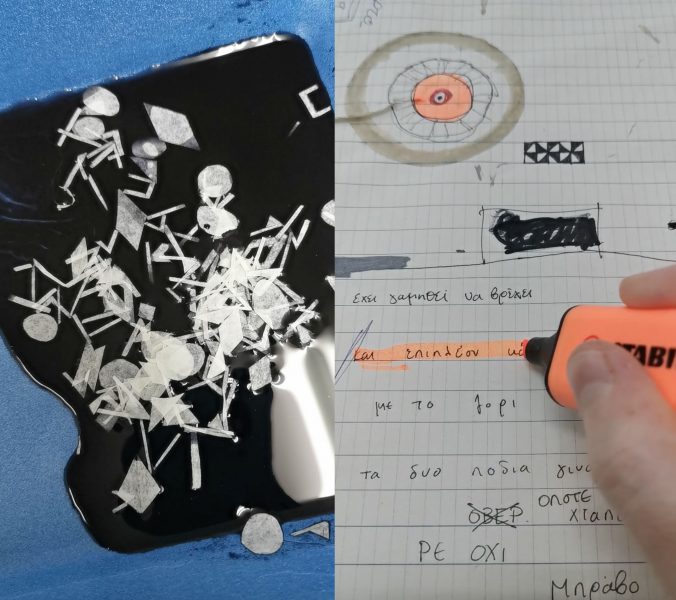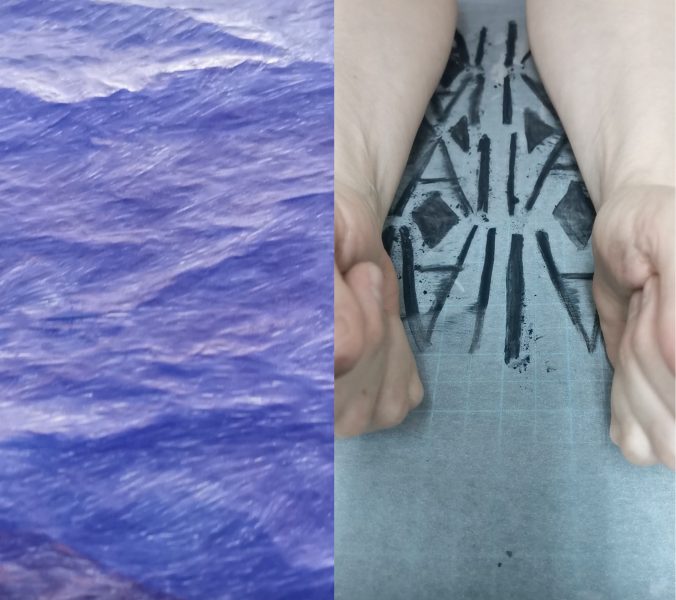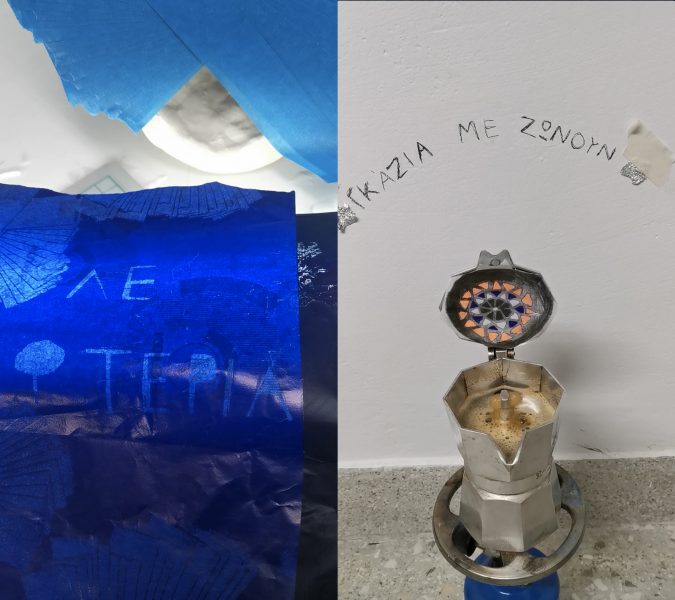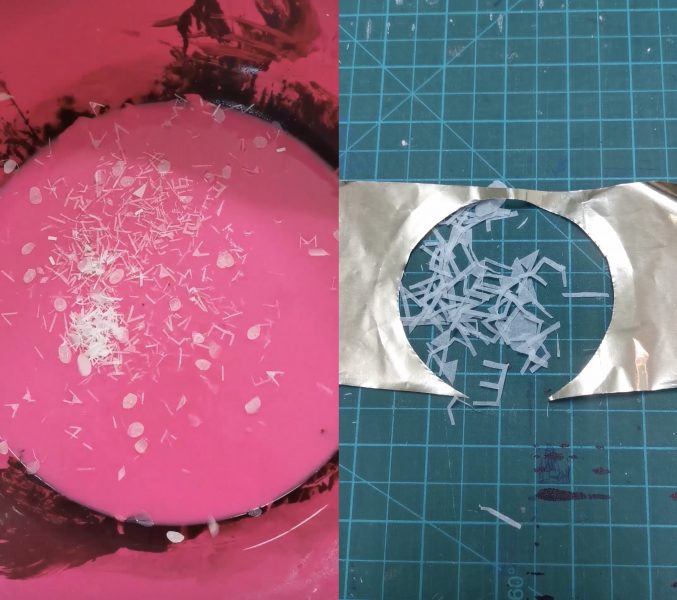Solo show “STORM (I Don’t Have a Pen)”, Μyrto Xanthopoulou
26.10.22 @ 18:00
STORM (I Don’t Have a Pen)
Myrto Xanthopoulou’s graduation show at the Athens School of Fine Arts in 2009 was a wonderful surprise, a jolt out of our comfort zone. Not trying to impress with grand gestures and extravagant statements, this was no ordinary graduation project. The artist made it clear that she did not seek to show ‘artworks’ but to temporarily inhabit space with her language and thought, treating walls, floor and ceiling as a blank page. She occupied space with words, phrases, notes, drawings, photographs, projections and constructions in low-cost, everyday materials, such as plastic bags, beer bottles and paper tape. Unlike her fellow students, Xanthopoulou dipped her brush in dictionaries and spoken language, proposing an alternative form of artistic expression and communication, one characterised by the poetry of the small gesture. Her exhibition had no focal point, no specific pieces on which viewers could focus. Visitors were invited to become readers – accomplices in the fragmentary narrative in which they were immersed. Phrases such as ‘If they were real, walls would be on our side,’ ‘A moment of silence for the old-timer who wears sneakers,’ Get out of the sea (blue stains)’ and ‘Get out of the fridge’ reveal an artist with a peculiar sense of humour. Born in the same country with Aki Kaurismäki, Xanthopoulou casually combines irony and tenderness, weirdness and a low-key sensitivity.
Over the following decade, Xanthopoulou held four interrelated solo exhibitions: each one fed the other, in the same way that her works are deconstructed and reworked into new ones. While the scattered small gestures became increasingly distinct and self-standing, her work evolved organically, displaying a crystal clarity. With exhibitions The Battleship (2013), Sing (2015), Rendering the Sky (2018) and ΜΠΟΥΦΑΝ (2020) the artist forged her artistic identity and developed an idiom of her own. She expanded her mediums, using carbon paper, various kinds of paper (packaging, drawing, continuous stationery, aluminium foil, sandpaper, maquette paper), clay, cement, bamboo sticks, balsa, lamps, fruit peels, even sea urchin spines. In her works, language gives disposable objects a new lease of life. Multiplied and folded onto the paper, ordinary words and phrases (Rubble, In the afternoon, Cicadas, Pigeons on Alexandras Ave.) form landscapes deluged with solid, illegible language patterns. Often, when papercutting, her word landscapes become perforated, reminiscent of lacework – it goes without saying that all her works are handmade. The artist reminds us that words – say, battleship – have multiple meanings. Her constructions, too, function as text, and the same applies to materials, which tell stories of ‘decline, lightness, heaviness, love.’ The eerie urban landscape of Athens is a constant reference and an endless source of inspiration, as is the home environment, the places in which the artist lives and works. When in Five Hundred Days in the Desert (2020) she holds a lighter to a large transparent paper sheet, creating concentric circles (and burning her finger in the process), she seems to provide a measure of the relentless flow of time in what is a bold statement of love for the depth of surface.
For STORM (I don’t have a pen), her fifth solo exhibition, Xanthopoulou temporarily camps at Aggeliki Chatzimichali’s residence. Designed specifically for this venue, the exhibition features a series of sculptures and a video, on view in three adjacent rooms. A composition with blue pen on tracing paper commands the main room, hanging above the elaborate fireplace. Written in large letters on the paper surface, the phrase ‘The tap is dripping’ conveys a warning message that needs no interpretation. For Xanthopoulou, in fact, language is a code; by every phrase she writes, she means something else. Similarly, STORM has a multiplicity of meaning, according to the artist: ‘There is a certain verticality about the title. A storm can involve crying, an outbreak, a sequence of events, of emotions, of words – a natural phenomenon when, as long as it is unfolding, everything else seems to come to a halt. There is something dramatic about this word, but it’s also a bit larger than life, almost funny (bringing to mind the Andipas song of the same title). It conveys the drama while undermining it at the same time.’ The artist notes that she sees all her works as text: ‘I generally have a textual perception of things. There are always words and phrases in my head – narratives around which I construct my works and understand them. And I still read them as a text even when it is absent.’
Xanthopoulou’s untold hardship is the physical suffering she endures when making her ‘luggage constructions,’ where ‘sloppiness goes hand in hand with an arduous, exhausting manual process.’ This ‘exhaustive appropriation’ is characteristic of all the sculptures in this exhibition, which feature phrases such as ‘I’m tired,’ ‘I don’t care’ and ‘We are all a mess.’ Packaging paper dipped in glue and oil paint, plaster bases that speak to the binary opposition light/heavy, a miniature kiosk with a plastic canopy, word and phrase fragments, mock-ups in wood and paper, bamboo buttresses, paper with imprints of the artist’s hands, words written in nail polish, papercuts with spray paint, a construction in cigarette paper that looks as if a spacecraft has just landed in the dining room – together, all these pieces make up an exhibition in which materiality and language, physicality and care take the spotlight.
In early incarnations, many of the objects embedded in these sculptures appear in the videos made on a smartphone and uploaded as Instagram Stories. This is ‘a collection of small gestures, shots and words, all woven together like handiwork.’ She notes that these videos compose an ‘experiential dictionary,’ a ‘record of gestures’ that illuminate various aspects of her practice – physical, performative, sonic. ‘They open a window to the inner world of the studio, the home, the lulls when nothing is happening, and anything can happen.’ In the ten-minute video 100KarateBlows (2021-22), on view in this exhibition as part of a construction, language operates similarly to a medium for sculpture. The artist’s voice constantly reiterates phrases (‘It’s all frequencies’/ ‘Same story every day’) which illustrate the performative nature of her practice. The videos are intentionally crude, made without any post-production: ‘It’s almost like a type of arte povera. I work with what I have, what I can find at home, in the studio, on the balcony, on the sidewalk, in my local paper shop,’ says the artist.
Looking at Xanthopoulou’s pieces on view in the museum space makes you feel as if a mischievous child has camped there, a child with ‘a profound need to record experience, with an acute awareness of the finite.’ Although her work is not directly related to folk art, it is linked to it by several of its qualities (geometry, patterns, writing, physicality, painstaking handiwork). Judging by the result, Xanthopoulou’s STORM was necessary – indeed ‘inescapable.’ The artist describes it perfectly: ‘As long as [the storm] lasts, nothing else exists / What’s left after the storm: fragments, traces of words / Then life goes on / Words are like mantras, like prayers / They are capsized, cut into syllables, into sounds; they come out with difficulty, drop to the ground, smashing into a thousand pieces / Words are lost in the raging storm / but we have nothing else; that’s all we have.’
Christoforos Marinos
Art historian
OPANDA curator of exhibitions and events
Translated by Dimitris Saltabassis
STORM (I Don’t Have a Pen)
Myrto Xanthopoulou
October 26 – November 27, 2022
Centre for Popular Craft & Tradition









